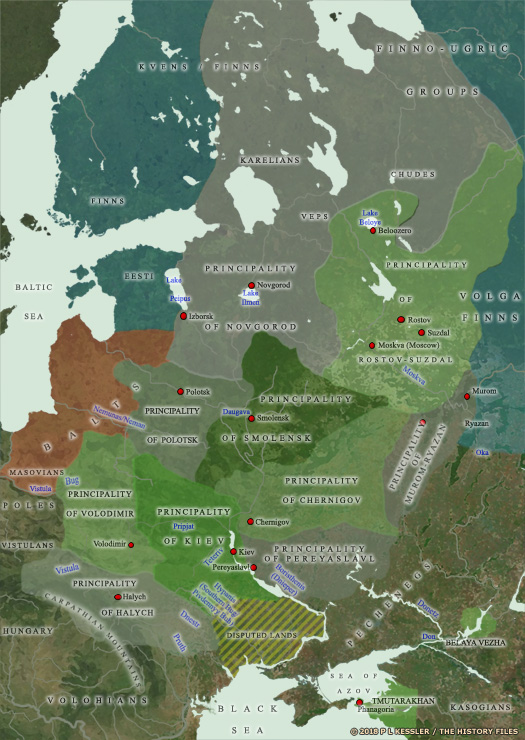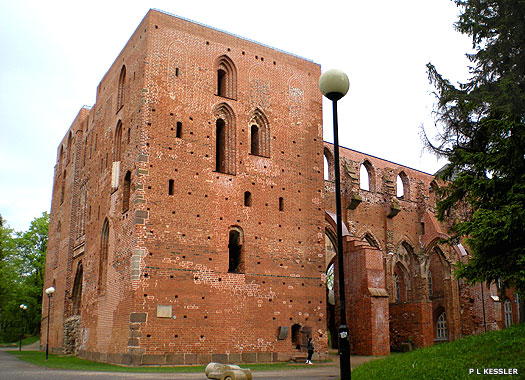 |
|
|
| (Information by Peter Kessler, from The Russian Primary Chronicle (Laurentian Text), Samuel Hazzard Cross & Olgerd P Sherbowitz-Wetzor (Eds and translators, Mediaeval Academy of America), from Novgorodskaia Pervaia Letopis' Starshego i Mladshego Izvodov, A N Nasonov (Ed, ANSSR, 1950), from The Chronicle of Novgorod 1016-1471, Michell & Forbes (Eds, Translators, Offices of the Society, London, 1914), from The History of the Baltic Countries, Zigmantas Kiaupa, Ain Mäesalu, Ago Pajur, & Gvido Straube (Eds, Estonia 2008), and from External Links: And it was given the name of Kyiv, Oleg Yastrubov, and The Fragmentation & Decline of Kievan Rus, and Encyclopaedia.com, and The Map Archive, and The Balts, Marija Gimbutas (1963, previously available online thanks to Gabriella at Vaidilute, but still available as a PDF - click or tap on link to download or access it).) |
|
|
| 1101 - ? |
Roman or Rogvolod? |
Son of Vseslav Briacheslavich 'the Sorcerer' of Polotsk. |
| 1101 |
Following the death of Vseslav Briacheslavich 'the Sorcerer' of Polotsk, the greater part of his principality has broken up into smaller states which include the principalities of Drutsk (Druck), Jersika, Koknese, Minsk, and Vitebsk.  The death of Yaroslav 'the Wise' in 1054 saw the end of the descent of Rurikid power via agnatic seniority. His division of the succession weakened Kyiv by creating what soon turned out to be rival principalities for each of his sons (click or tap on map to view full sized) The death of Yaroslav 'the Wise' in 1054 saw the end of the descent of Rurikid power via agnatic seniority. His division of the succession weakened Kyiv by creating what soon turned out to be rival principalities for each of his sons (click or tap on map to view full sized) |
|
| Vseslav's eldest son, Roman, has gained Drutsk but appears to die early, possibly even before his father's death. Rogvolod, a younger brother, has inherited that. Gleb has gained Minsk, Davyd now has Polotsk, Sviatoslav has Vitebsk, and Rotislav has possibly gained Lukoml. Just who holds Koknese, or even whether it is independent until later in the century, seems to be unclear. One near-contemporary source mentions Vetseke as a son of the prince of Drutsk, which would make it likely that either Roman or Rogvolod is his grandfather or great-grandfather. Vetseke most likely governs it as a newly-created independent territory of Drutsk (independent because Drutsk never seems to attempt to reclaim it). |
|
|
| ? - c.1180s |
? |
Son and/or grandson? |
| c.1180s - 1208 |
Vyachko / Vetseka / Vetseke |
Son? Prince of Koknese. Fled. Killed in 1224. |
| 1205 |
According to the (German) sources, Vetseke gives half of his territory to Albert, bishop of Riga, in return for protection against the duchy of Samogitia and the principality of Polotsk. Albert sends troops to support him, thereby establishing a small German community within the town. |
|
| 1208 |
During a raid by the Order of the Knights of the Sword, Vetseke is captured and delivered in chains to Riga, where the bishop sets him free. Returning to his capital, and with the bishop having embarked upon a return to Germany, Vetseke rebels against his enforced subservience, kills every German in his territory, and calls to Polotsk for support. The bishop returns all too quickly with his own army, so Vetseke burns down his castle and retreats to Novgorod. |
|
| 1209 - 1238 |
Koknese is taken over by the Order of the Knights of the Sword by 1209. Vetseke, though, continues to fight to establish a domain of his own. Polotsk's sovereignty over the town is terminated in 1215, bringing this small state to a definite end. It is transferred into the ownership of the bishop of Riga in 1238. |
|
| 1220 - 1224 |
The Unguenois rebel against their German overlords. They are encouraged by the Sakalians who send them the bloody swords of Germans they have killed. The Unguenois decide to side with Novgorod, with the result that the Rus princes of Polotsk, Novgorod, and Suzdal send around twenty thousand men to their aid. Prince Vetseke is left in charge of the Unguenois and any other Estonians who will submit to him. German crusaders recapture all of the rebellious Estonian provinces in 1224 and Vetseke is reduced to holding just the Unguenois centre at Tharbata. Bishop Hermann of Buxhoeveden takes control of Ugaunia from his base in Dorpat while the Order of the Knights of the Sword is granted control of Sakala. Tharbata is conquered later in 1224 and all of its Unguenois and Rus defenders are killed, Vetseke included. The relief army has reached nearby Pskov when news of the fall reaches it.  Tartu's modern ruins of the Dome Hill Church or cathedral date back to 1234, when a stone fortress replaced the original wooden one of the Unguenois in which Prince Vetseke had died (click or tap on image to view full sized) Tartu's modern ruins of the Dome Hill Church or cathedral date back to 1234, when a stone fortress replaced the original wooden one of the Unguenois in which Prince Vetseke had died (click or tap on image to view full sized) |
|
 |
|
|

 The death of Yaroslav 'the Wise' in 1054 saw the end of the descent of Rurikid power via agnatic seniority. His division of the succession weakened Kyiv by creating what soon turned out to be rival principalities for each of his sons (click or tap on map to view full sized)
The death of Yaroslav 'the Wise' in 1054 saw the end of the descent of Rurikid power via agnatic seniority. His division of the succession weakened Kyiv by creating what soon turned out to be rival principalities for each of his sons (click or tap on map to view full sized) Tartu's modern ruins of the Dome Hill Church or cathedral date back to 1234, when a stone fortress replaced the original wooden one of the Unguenois in which Prince Vetseke had died (click or tap on image to view full sized)
Tartu's modern ruins of the Dome Hill Church or cathedral date back to 1234, when a stone fortress replaced the original wooden one of the Unguenois in which Prince Vetseke had died (click or tap on image to view full sized)